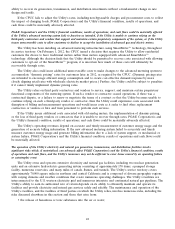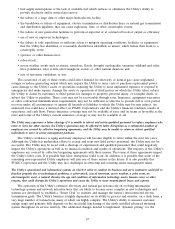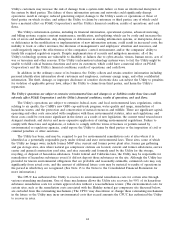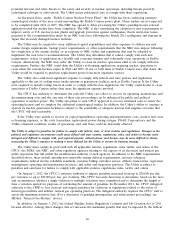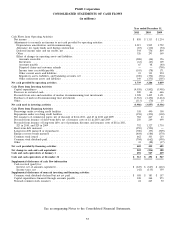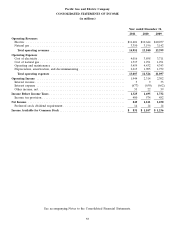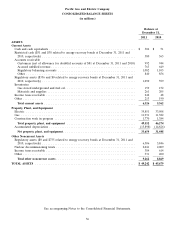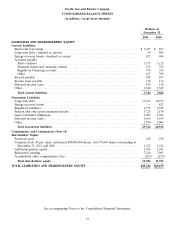PG&E 2011 Annual Report Download - page 53
Download and view the complete annual report
Please find page 53 of the 2011 PG&E annual report below. You can navigate through the pages in the report by either clicking on the pages listed below, or by using the keyword search tool below to find specific information within the annual report.restrict PG&E Corporation’s ability to pay principal and interest on its outstanding debt or pay its common stock
dividend, meet other obligations, or execute its business strategy. Further, laws or regulations could be enacted or
adopted in the future that could impose additional financial or other restrictions or requirements pertaining to
transactions between a holding company and its regulated subsidiaries.
PG&E Corporation’s and the Utility’s financial condition, results of operations, and cash flows will be affected by their
ability to continue accessing the capital markets and by the terms of debt and equity financings.
The Utility relies on access to capital and credit markets as significant sources of liquidity to fund capital
expenditures, pay principal and interest on its debt, provide collateral to support its natural gas and electricity
procurement hedging contracts, and fund other operations requirements that are not satisfied by operating cash
flows. See the discussion of the Utility’s future financing needs above in ‘‘Liquidity and Financial Resources.’’ PG&E
Corporation relies on independent access to the capital and credit markets to fund its operations, make capital
expenditures, and contribute equity to the Utility as needed to maintain the Utility’s CPUC-authorized capital
structure, if funds received from the Utility (in the form of dividends or share repurchases) are insufficient to meet
such needs. PG&E Corporation may also be required to access the capital markets when the Utility is successful in
selling long-term debt so that PG&E Corporation can contribute equity to the Utility as needed to maintain the
Utility’s authorized capital structure.
PG&E Corporation’s and the Utility’s ability to access the capital and credit markets and the costs and terms of
available financing depend on many factors, including changes in their credit ratings; changes in the federal or state
regulatory environment affecting energy companies generally or PG&E Corporation and the Utility in particular; the
overall health of the energy industry; volatility in electricity or natural gas prices; disruptions, uncertainty or volatility
in the capital and credit markets; and general economic and market conditions. If PG&E Corporation’s or the
Utility’s credit ratings were downgraded to below investment grade, their ability to access the capital and credit
markets could be negatively affected and could result in higher borrowing costs, fewer financing options, including
reduced access to the commercial paper market, lower capital spending levels, and additional collateral posting
requirements, which in turn could impact liquidity and lead to an increased financing need.
If the Utility were unable to access the capital markets, it could be required to decrease or suspend dividends to
PG&E Corporation. PG&E Corporation also would need to consider its alternatives, such as contributing capital to
the Utility, to enable the Utility to fulfill its obligation to serve. If PG&E Corporation is required to contribute
equity to the Utility in these circumstances, it would be required to seek these funds from the capital or credit
markets.
The completion of capital investment projects is subject to substantial risks, and the timing of the Utility’s capital
expenditures and recovery of capital-related costs through rates, if at all, will directly affect net income.
The Utility’s ability to make capital investments in its electric and natural gas businesses is subject to many risks,
including risks related to obtaining regulatory approval, securing adequate and reasonably priced financing, obtaining
and complying with the terms of permits, meeting construction budgets and schedules, and satisfying operating and
environmental performance standards. Third-party contractors on which the Utility depends to develop or construct
these projects also face many of these risks. Changes in tax laws or policies, such as those relating to production and
investment tax credits for renewable energy projects, may also affect when or whether a potential project is
developed. The development of proposed Utility-owned renewable energy projects may also be affected by the extent
to which necessary electric transmission facilities are built and evolving federal and state policies regarding the
development of a ‘‘smart’’ electric transmission grid. In addition, reduced forecasted demand for electricity and
natural gas as a result of an economic slow-down may also increase the risk that projects are deferred, abandoned, or
cancelled.
49





